Honda ZR-V Review 2024
Written by Richard Aucock
Quick overview
Pros
- Smooth and efficient hybrid powertrain
- High-quality interior with intuitive technology
- One of the best crossover SUVs to drive
Cons
- Less luggage capacity than many rivals
- Can be expensive to buy new
- Styling is a little anonymous
Overall verdict on the Honda ZR-V
“Honda has put its own unique slant on the family SUV. The ZR-V is good to drive, efficient to run and packed with plenty of intuitive technology.”
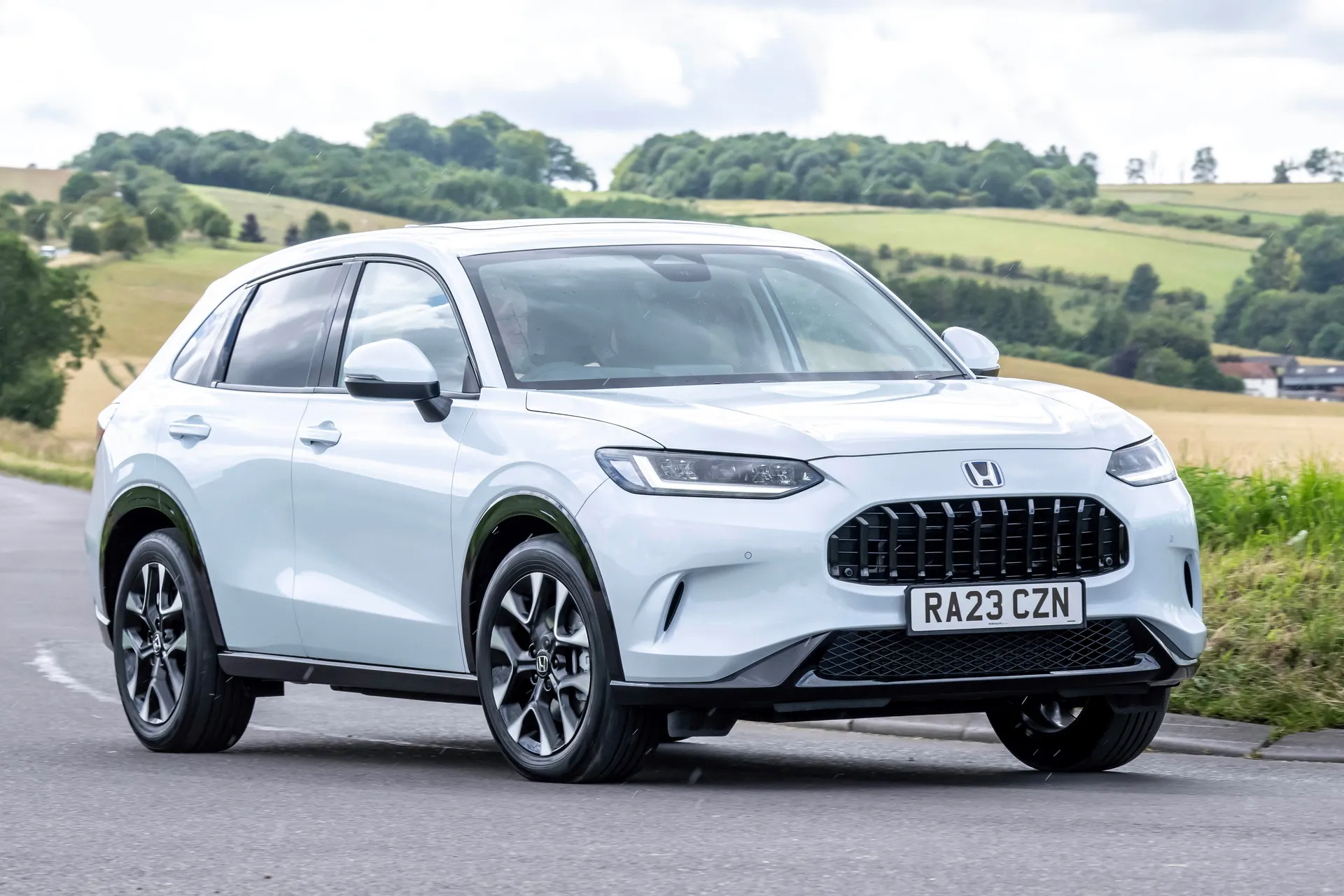
The Honda ZR-V is a hybrid-powered family SUV, which slots into the Japanese company’s range between the HR-V and CR-V models.
It borrows much from the latest Honda Civic family hatchback, including a clever powertrain and a smart interior. Compared to other family-friendly rivals like the Kia Sportage, Nissan Qashqai and Hyundai Tucson, the ZR-V certainly stands out as an intriguing option.
Honda does have a reputation for putting plenty of innovative engineering into its products, and the ZR-V does not disappoint here. Its e:HEV powertrain is a genuine marvel, combining a 2.0-litre petrol engine with a pair of electric motors.
In most circumstances, the petrol engine does not directly power the front wheels, acting instead as a generator to charge the lithium-ion battery for the electric motors. At higher speeds, the clever e-CVT gearbox can allow a direct link between the engine and front wheels, juggling this transition seamlessly.
The result is an SUV that feels relatively quick to drive, thanks to the instant responses from its electric motors. Yet at the same time, it can offer an official fuel consumption of almost 50mpg – and without needing to be plugged in to charge.
On top of this, the Honda ZR-V is a genuinely enjoyable car to drive, channelling much of the Civic on which it is based. It is certainly one of the most fun family SUVs, with suspension that strikes a great balance between comfort and control.
Not everything is perfect in the ZR-V, though. Although its high-quality interior is packed with plenty of equipment, this is not the most spacious SUV on sale. A boot capacity of 380 litres is actually less than the Civic it shares a platform with, while getting three adults onto the rear bench seat could be a squeeze.
Buying a new Honda ZR-V is likely to be a squeeze on your wallet, too. Prices start at just under £39,500 for the entry-level Elegance model, rising to almost £43,000 for the range-topping Advance version (correct at the time of writing). It could certainly pay to check out a nearly-new example and make a saving instead.
There is a lot to like about the Honda ZR-V, not least because it does things in a slightly different way to most other family SUVs. If you want efficient hybrid power with a degree of driving fun, the Honda could be a winner.
Looking for a used car for sale? We've got 100s of Honda Approved Used Cars for Sale for you to choose from, including a wide range of Honda ZR-Vs for sale.
Is the Honda ZR-V right for you?
Unlike some hybrids, the Honda ZR-V does not need to be plugged in. And along with its smooth and efficient powertrain, the ZR-V also manages to be surprisingly engaging to drive.
Factor in a high-quality interior, packed with the latest technology, and this high-riding Honda becomes a very compelling option.
What's the best Honda ZR-V model/engine to choose?
Honda offers the ZR-V solely with just one engine option: the e:HEV hybrid fitted across the range. This is a good thing, though, given its blend of performance, efficiency and overall smoothness. The e-CVT gearbox is a genuine technological marvel, helping juggle power between the engine and electric motors with ease.
When it comes to trim levels, Honda has been generous across the range. The entry-level Elegance model is actually the quickest and most efficient version, on paper at least. In reality, there are only minimal differences between the other models, although the Elegance will be cheaper to tax.
The range-topping Honda ZR-V Advance piles on the extras, including a full leather interior and a panoramic sunroof. This does make the ZR-V rather costly, though.
Sport specification is perhaps the best compromise, bringing extra niceties such as a power-operated tailgate, plusher seat upholstery and some tasteful styling additions.
What other cars are similar to the Honda ZR-V?
Being a family SUV, there are no end of alternatives to the Honda ZR-V – including cars with hybrid powertrains. The Hyundai Tucson and Kia Sportage are both available as self-charging hybrids (along with plug-in versions), making them close competitors.
Potential Honda ZR-V buyers have the Renault Austral and Nissan Qashqai to consider as well.
Technically, the most similar vehicle actually comes from within Honda’s own stable. Lending its platform and powertrain to the ZR-V is the latest Honda Civic e:HEV hybrid. It feels much the same as the ZR-V, just in hatchback form.
Comfort and design: Honda ZR-V interior
“Honda has used the same interior design for the ZR-V as that found in the Civic hatchback, which can only be a good thing.”
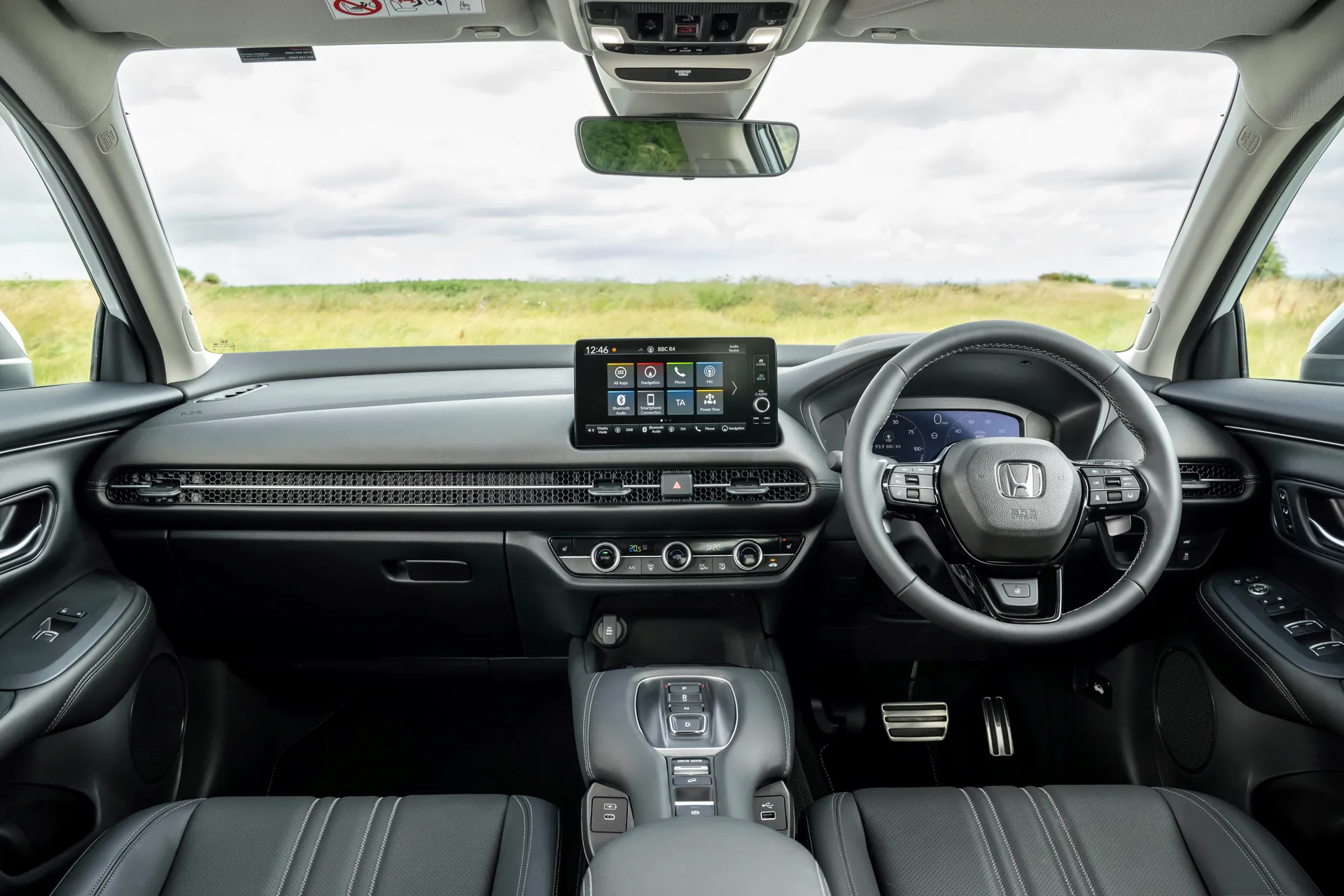
Forget any ideas of being overwhelmed with chintzy details and unnecessary styling quirks. Instead, Honda has chosen to keep things pleasingly simple inside the ZR-V, following the path taken with the latest Civic.
Honda has positioned the dashboard quite low, much like a hatchback, and the overall driving position is not quite as elevated as in other SUVs. There is still plenty of visibility out front, but the view from the rear is more restricted. Thankfully, parking sensors and a reversing camera are included as standard across the range.
The front seats are comfortable, and come with manual adjustment on entry-level Elegance models. Both Sport and Advance versions feature multi-way electrical movement, although there is noticeable lack of lumbar adjustment.
At least all models come with heated front seats, with heating added to the outer rear pair of seats on the ZR-V Advance, too.
Quality and finish
Honda is on a roll with interior design and quality at the moment, with the ZR-V continuing the good work started with the latest Civic. The ZR-V borrows much from its hatchback cousin, which is certainly not a bad thing.
The ZR-V’s interior quality sits on a par with the Mazda CX-5, being better than mainstream rivals like the Nissan Qashqai, but not quite on a par with premium models such as the BMW X3.
Almost everything you touch feels made to last, and the metal honeycomb air vent across the dashboard is a real touch of class. The metal paddles for the regenerative braking settings are also noteworthy.
Go rooting around lower down in the ZR-V and you will find some cheaper plastics, but this is true for almost every family SUV on sale today.
Advance model ZR-Vs look the plushest inside, thanks to their full synthetic-leather upholstery.
Infotainment: Touchscreen, USB, sat nav and stereo in the Honda ZR-V
Honda has not been known for producing great infotainment systems, but things are certainly moving in the right direction. Using the same setup as the latest Civic means the ZR-V comes with a 9.0-inch central touchscreen.
The graphics look a little dated, but the screen reacts quickly to inputs, which is more important. There are physical ‘home’ and ‘back’ buttons to make life easier, too.
Satellite navigation is included on all versions, along with a DAB radio. Wireless Apple CarPlay and wired Android Auto smartphone connectivity is included, too.
Elegance models come with two USB connections in the front, with two more in the rear on Sport and Advance versions. Higher-spec cars come with wireless smartphone charging, too.
Do you remember when cars used to come with physical buttons and switches to control things like the air conditioning? Thankfully Honda does, and it means the ZR-V has a pleasing row of dials for the climate control, along with a proper volume knob for the infotainment. Praise be.
Space and practicality: Honda ZR-V boot space
The Honda ZR-V is positioned between the HR-V and CR-V in the company’s model range, measuring 4568mm in length and 1840mm in width.
In the front there is plenty of space, although headroom is reduced slightly in Advance models due to the standard panoramic sunroof.
Back-seat passengers get a good deal, with a decent amount of legroom and the ability to carry two adults in comfort. Although the rear bench can accommodate a third person, the central middle seat is quite narrow, so is best reserved for shorter trips.
If there is a chink in the Honda ZR-V’s armour, boot capacity may be it. With the rear seats in place, it can carry only 380 litres of luggage, and the range-topping Advance model loses a further 10 litres thanks to the subwoofer for its upgraded audio system.
By comparison, a hybrid-powered Kia Sportage can carry 587 litres by the same measure. More surprisingly, the ZR-V comes with less boot space than the 410-litre capacity found in the Honda Civic it shares a platform with.
Folding the back seats down does boost luggage capacity to 1312 litres, however, and the rear bench can split 60:40 if needed.
Handling and ride quality: What is the Honda ZR-V like to drive?
“It may not be the highest benchmark to meet, but the Honda ZR-V is easily one of the best SUVs to drive in its class.”
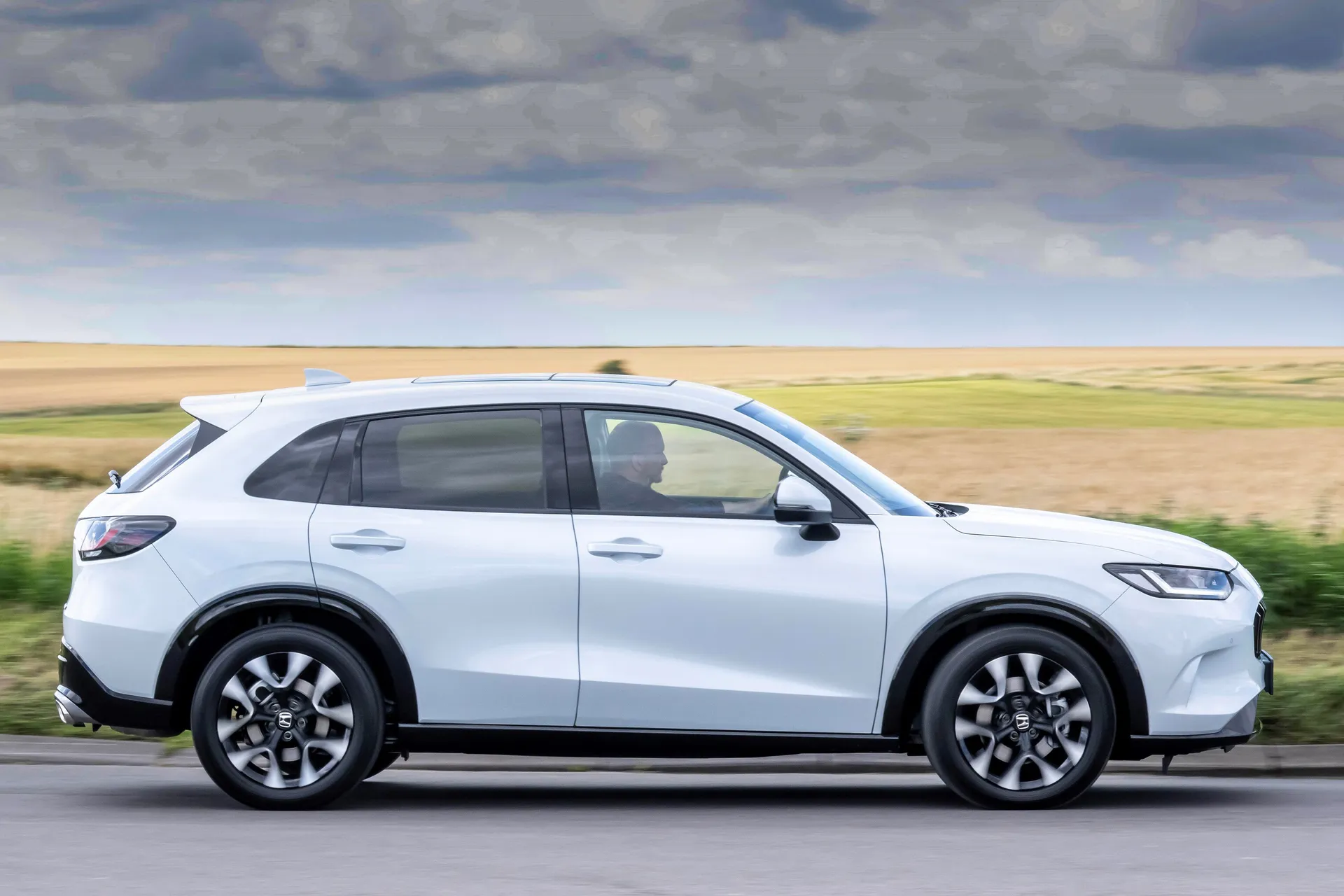
Family SUVs are not typically renowned for their handling prowess, but the Honda ZR-V is one of the exceptions to the rule. It cannot quite match the Honda Civic it shares a platform with, but is certainly streets ahead of rivals such as the Nissan Qashqai and Hyundai Tucson.
The ZR-V’s steering is not bursting with feel, and is quite light in standard mode. Switching to Sport mode adds some extra weight, though. Whatever the driving mode, the ZR-V handles neatly and precisely, aided by plenty of grip. Only a Mazda CX-5 offers a similar driving experience in this class, but that does not come with a hybrid powertrain option.
Honda has put substantial effort into engineering the ZR-V’s suspension setup. It manages to be comfortable, easily absorbing bumps in the road, but also keeps body-roll in check.
Helping the ZR-V is Honda’s decision to stick with offering only 18-inch alloy wheels across the range. In a world where every SUV seems to come with 20-inch wheels, the Honda’s taller tyres are a bonus for ride comfort, absorbing potholes effectively.
What engines and gearboxes are available in the Honda ZR-V?
Honda’s e:HEV self-charging hybrid system is the only powertrain available for the ZR-V, so you do not need to worry about making choices here.
It consists of a 2.0-litre naturally aspirated four-cylinder petrol engine, combined with a pair of electric motors and fed by a 1.05kWh battery pack. The system drives through Honda’s e-CVT gearbox, with power sent to the front wheels.
It is genuinely clever tech, with the petrol engine spending most of its time functioning as a generator to charge the battery. The ZR-V can function in pure electric mode for short periods of time, before the petrol engine kicks in for recharging purposes. During these times, the engine is not physically powering the front wheels.
However, when driving at higher speeds on the motorway, the transmission allows the petrol engine to send power directly to the front wheels. This juggling of power all happens seamlessly – you won’t even notice it.
A combined output of 184PS and 315Nm of torque is respectable, aided by the instant reactions of the electric motor. The 0-62mph sprint takes between 7.8 and 8.0 seconds, depending on the trim level.
Honda has replicated the impression of gear changes into the e-CVT gearbox, avoiding the constant engine blare often experienced with regular CVT transmissions. The brakes help regenerate battery power but, similar to other hybrids, are lacking in feel.
Refinement and noise levels
The big advantage of Honda’s hybrid setup is how it can make the ZR-V feel particularly refined to drive. In electric mode it is as quiet as a pure EV, and the petrol engine remains fairly hushed when it is called upon for extra power.
Even at motorway speeds, where the engine can drive the front wheels directly, wind noise from the side mirrors is likely to be the most obvious sound.
Forget worries about the e-CVT gearbox doing the classic CVT trick of revving like mad, too. Instead, it works more like a smooth conventional automatic gearbox.
Safety equipment: How safe is the Honda ZR-V?
The Honda ZR-V has recently been tested by the Euro NCAP safety organisation, which assessed how it performs in a variety of scenarios. The ZR-V missed out on the coveted five-star maximum rating by a small percentage, being awarded four stars overall.
This included scores of 79 percent for adult occupants and 68 percent for safety assistance systems. These figures were just below the threshold for the top rating, meaning the ZR-V is still a very safe SUV.
Standard safety equipment includes forward collision warning, road departure mitigation, lane-keeping assistance, and an intelligent speed limiter.
MPG and fuel costs: What does a Honda ZR-V cost to run?
“The hybrid does exactly what Honda says it should, making the ZR-V capable of some impressive fuel economy figures in the real world.”
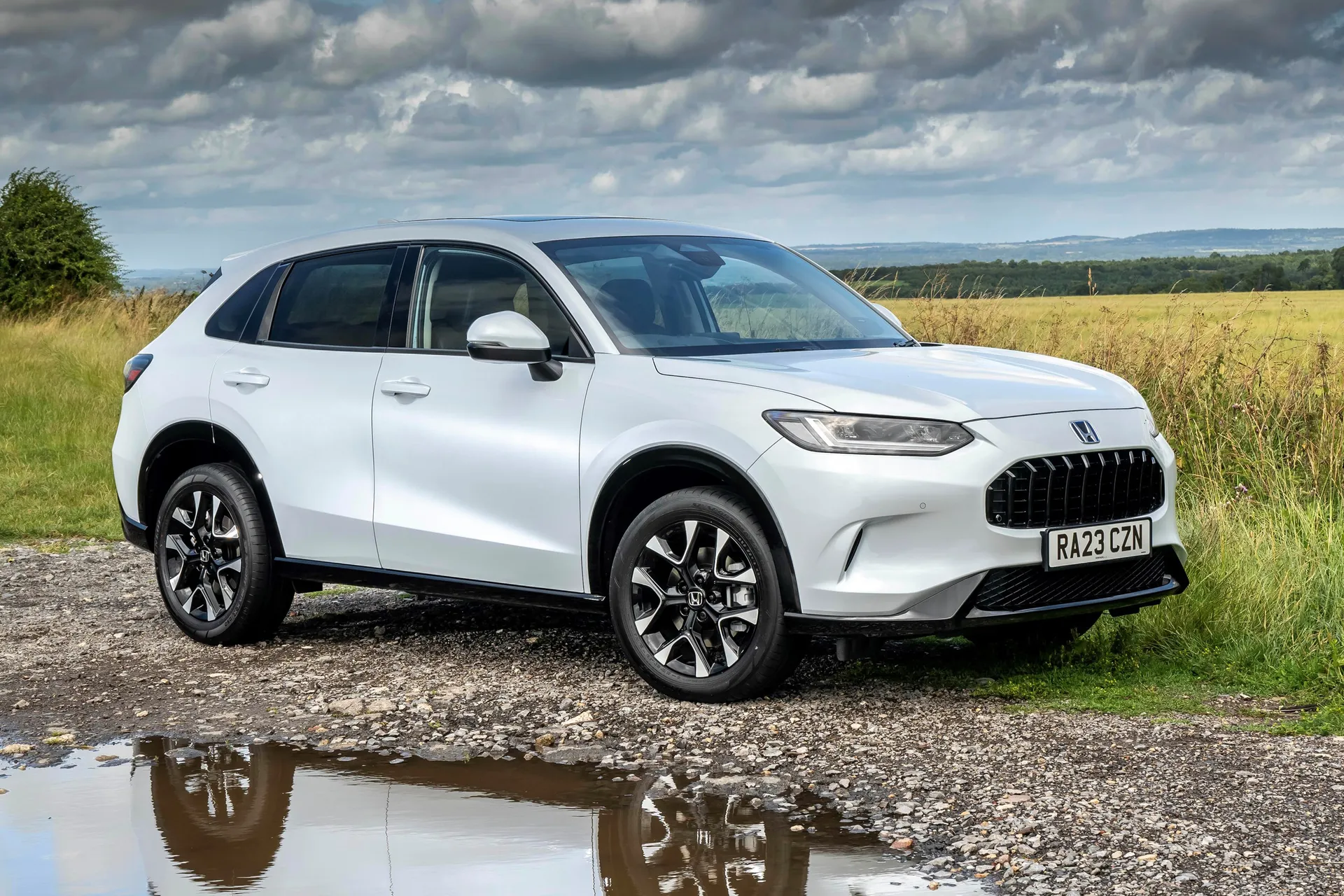
At the heart of Honda’s decision to fit the ZR-V with its hybrid powertrain is a desire to offer the best of both worlds. An electric motor for use in urban areas, and when cruising, but with a petrol engine when extra power is needed.
It seems to work well for fuel economy, with official WLTP-tested combined averages of between 48.7mpg and 49.6mpg depending on the trim level chosen.
The cheapest Elegance version is the most efficient on paper, but real-world economy of around 45mpg should be easily achievable across the range. Try a bit harder and numbers north of 50mpg shouldn’t be impossible.
For those who predominantly do urban driving, a plug-in hybrid may be a better option, though.
How reliable is the Honda ZR-V?
The Honda ZR-V is very new to the market, so there has not been enough time for potential issues to crop up. It’s worth noting that the mechanically similar Honda Civic hybrid has not produced any major worries so far.
Honda finished an impressive sixth for overall brand reliability in the latest Honest John Satisfaction Index survey.
A three-year or 90,000-mile warranty is included, while the lithium-ion battery and hybrid system are covered for five-years or 90,000-miles.
Insurance groups and costs
The Honda ZR-V finds itself with a relatively high insurance group rating of 35 out of 50. This applies the same to all trim levels, so at least there is no penalty for picking the fancier Sport or Advance models.
By comparison, the hybrid-powered versions of the Kia Sportage or Hyundai Tucson do not rise above insurance group 25. This could make the ZR-V more expensive to insure, so be sure to shop around for the best possible deal.
VED car tax: What is the annual road tax on a Honda ZR-V?
Buying the Elegance version of the Honda ZR-V means a cost of £200 for the first-year of VED (road tax), with the Sport and Advance models charged at £245.
For years two to five, the ZR-V Elegance will see a VED rate of £170, with the Sport and Advance costing £560 each year. This is because the list price of the latter two models takes them above the £40,000 threshold.
For company car drivers, the ZR-V is not the cheapest hybrid SUV around. Those in the 20 percent tax bracket will pay £203 a month in Benefit-in-Kind for the Elegance model, with 40 percent ratepayers needing to find £406 each month.
How much should you be paying for a used Honda ZR-V?
“The Honda ZR-V is very new to the market but, you could still find a nearly-new example available from less than £36,000.”
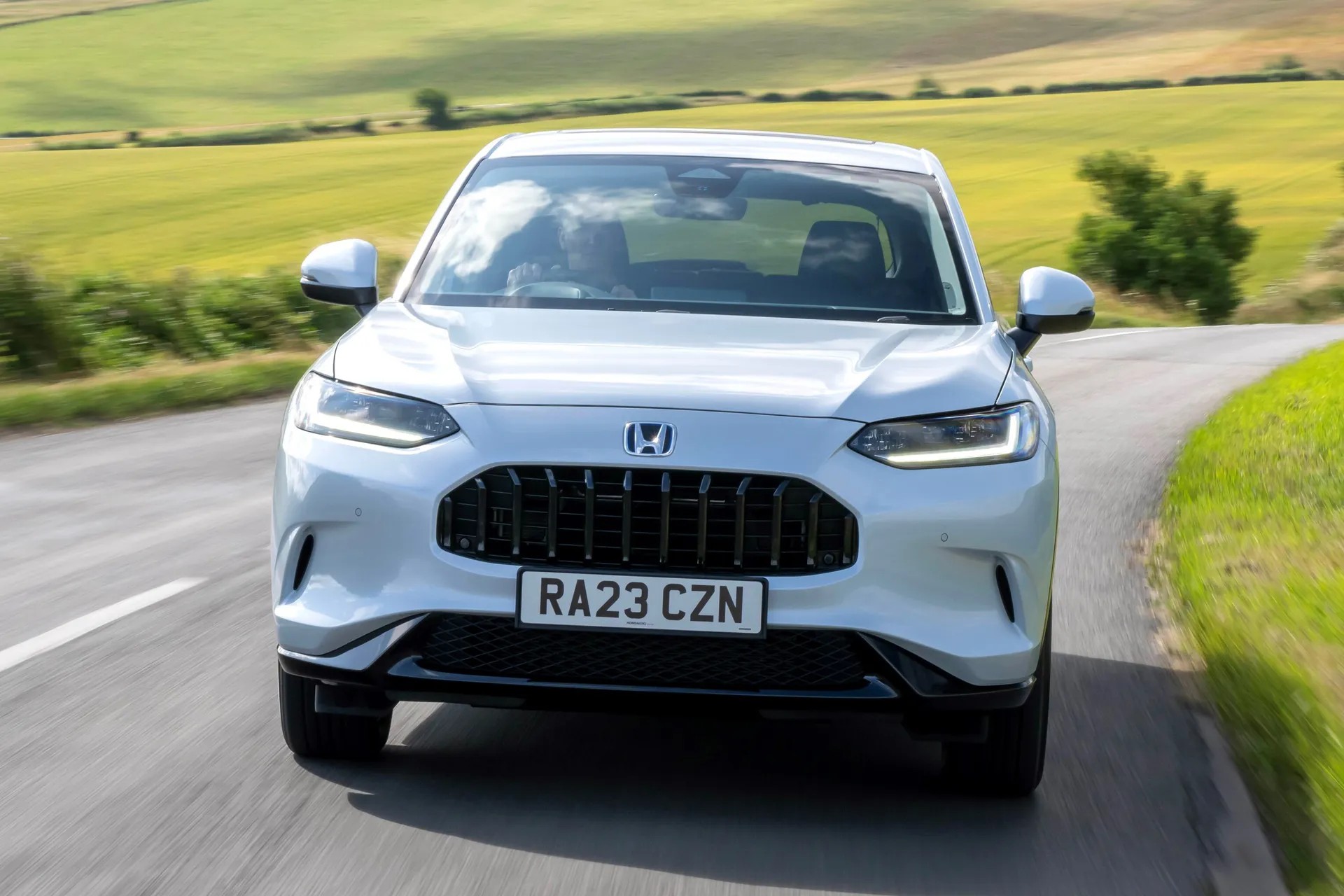
The Honda ZR-V only went on sale in the UK in 2023, meaning it has yet to reach these shores in large numbers. There are ZR-Vs on offer with Honda dealerships, though, and the Sport model seems to be the most popular so far.
A Honda ZR-V Sport with around 3,000 miles on the odometer could cost less than £36,000. The range-topping Advance, with a similar mileage, will be in the region of £39,000.
Trim levels and standard equipment
Helping justify a strong list price for the Honda ZR-V is a comprehensive amount of standard equipment. This applies across the model range.
Elegance trim is the starting point, with 18-inch gunmetal grey alloy wheels, automatic LED headlights, LED tail lights, front and rear parking sensors, and a rear-view camera all included.
The interior of the Honda ZR-V Elegance comes with cloth upholstery, with the front seats also heated. Other features include a leather-wrapped steering wheel, digital instrument panel, dual-zone climate control and an eight-speaker sound system.
Honda fits a 9.0-inch infotainment touchscreen as standard, which includes DAB radio and Bluetooth, plus connectivity for Android Auto and wireless Apple CarPlay. Two USB ports are included up front as well.
The mid-range Honda ZR-V Sport comes with 18-inch alloy wheels in a matt black finish, privacy glass and a black honeycomb front grille. Gloss black is used for the window surrounds, there are black mirror caps, and the Sport gains its own bespoke front bumper design.
On the inside, the Sport comes with seats finished in a combination of fabric and black leather, with a set of aluminium pedals added. The driver’s seat comes with power height adjustment, the tailgate can be opened and closed electrically with a kick sensor, and there are two extra USB ports in the rear.
At the top of the ladder is the Honda ZR-V Advance, wearing 18-inch alloy wheels in a gloss black with a diamond-cut finish. A panoramic glass sunroof is fitted and there is even ambient lighting for the door handles.
Black leather upholstery is used for the Advance, with contrasting silver stitching. Both the front and rear seats are heated, along with the steering wheel.
A 6.0-inch head-up display is included for good measure. Completing the package is a Bose sound system with 12 speakers and a subwoofer.
Ask the heycar experts: common questions
Is the Honda ZR-V an electric SUV?
How fast is the Honda ZR-V?
Can the Honda ZR-V go off-road?
Get our latest advice, news and offers
Keep me updated by email with the latest advice, news and offers from heycar.
By submitting you agree to our privacy policy



